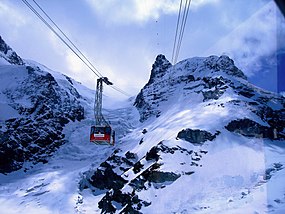| Klein Matterhorn | |
|---|---|
 The Klein Matterhorn from the aerial tramway | |
| Highest point | |
| Elevation | 3,883 m (12,740 ft) |
| Prominence | 88 m (289 ft) |
| Parent peak | Breithorn |
| Coordinates | 45°56′18″N 7°43′47″E / 45.93833°N 7.72972°E |
| Naming | |
| English translation | Little Matterhorn |
| Geography | |
| Location | Zermatt, Valais, Switzerland |
| Parent range | Pennine Alps |
| Climbing | |
| First ascent | 1789 by Horace-Bénédict de Saussure |
| Easiest route | Aerial tramway |
The Klein Matterhorn (sometimes translated as Little Matterhorn) is a peak of the Pennine Alps, overlooking Zermatt in the Swiss canton of Valais. At 3,883 metres (12,740 ft) above sea level, it is the highest place in Europe that can be reached by aerial tramway or gondola lift, as well as by any other means of transport. The Klein Matterhorn is part of the Breithorn massif and overlooks on its south side the almost equally high flat glacier named Breithorn Plateau, just north of the international border with Italy. The name "Klein Matterhorn" is a reference to its much larger neighbour, the Matterhorn, which lies 7 km (4.3 mi) away across the Theodul Pass.
The Klein Matterhorn, with the adjacent ski-lifts to the slightly higher Gobba di Rollin, is also a year-round ski area, marketed as "Matterhorn Glacier Paradise", and part of the international ski area between Zermatt and Breuil-Cervinia.
Fast ascents to a height above 3,000 metres (9,800 ft) will frequently lead to headaches or other symptoms of altitude sickness with sensitive people.
